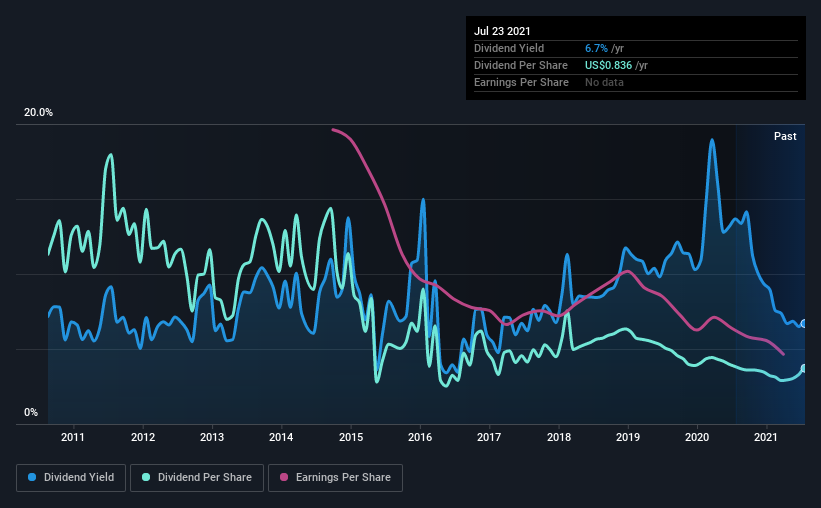Do These 3 Checks Before Buying Cross Timbers Royalty Trust (NYSE:CRT) For Its Upcoming Dividend
It looks like Cross Timbers Royalty Trust (NYSE:CRT) is about to go ex-dividend in the next four days. The ex-dividend date is usually set to be one business day before the record date which is the cut-off date on which you must be present on the company's books as a shareholder in order to receive the dividend. The ex-dividend date is an important date to be aware of as any purchase of the stock made on or after this date might mean a late settlement that doesn't show on the record date. Thus, you can purchase Cross Timbers Royalty Trust's shares before the 29th of July in order to receive the dividend, which the company will pay on the 13th of August.
The company's next dividend payment will be US$0.12 per share. Last year, in total, the company distributed US$0.65 to shareholders. Last year's total dividend payments show that Cross Timbers Royalty Trust has a trailing yield of 6.7% on the current share price of $12.48. We love seeing companies pay a dividend, but it's also important to be sure that laying the golden eggs isn't going to kill our golden goose! As a result, readers should always check whether Cross Timbers Royalty Trust has been able to grow its dividends, or if the dividend might be cut.
Check out our latest analysis for Cross Timbers Royalty Trust
Dividends are usually paid out of company profits, so if a company pays out more than it earned then its dividend is usually at greater risk of being cut. Last year, Cross Timbers Royalty Trust paid out 100% of its income as dividends, which is above a level that we're comfortable with, especially if the company needs to reinvest in its business.
Click here to see how much of its profit Cross Timbers Royalty Trust paid out over the last 12 months.
Have Earnings And Dividends Been Growing?
Businesses with shrinking earnings are tricky from a dividend perspective. If business enters a downturn and the dividend is cut, the company could see its value fall precipitously. With that in mind, we're discomforted by Cross Timbers Royalty Trust's 14% per annum decline in earnings in the past five years. Ultimately, when earnings per share decline, the size of the pie from which dividends can be paid, shrinks.
Another key way to measure a company's dividend prospects is by measuring its historical rate of dividend growth. Cross Timbers Royalty Trust has seen its dividend decline 11% per annum on average over the past 10 years, which is not great to see. While it's not great that earnings and dividends per share have fallen in recent years, we're encouraged by the fact that management has trimmed the dividend rather than risk over-committing the company in a risky attempt to maintain yields to shareholders.
Final Takeaway
Is Cross Timbers Royalty Trust an attractive dividend stock, or better left on the shelf? Not only are earnings per share shrinking, but Cross Timbers Royalty Trust is paying out a disconcertingly high percentage of its profit as dividends. Generally we think dividend investors should avoid businesses in this situation, as high payout ratios and declining earnings can lead to the dividend being cut. Cross Timbers Royalty Trust doesn't appear to have a lot going for it, and we're not inclined to take a risk on owning it for the dividend.
With that being said, if you're still considering Cross Timbers Royalty Trust as an investment, you'll find it beneficial to know what risks this stock is facing. To that end, you should learn about the 5 warning signs we've spotted with Cross Timbers Royalty Trust (including 1 which doesn't sit too well with us).
We wouldn't recommend just buying the first dividend stock you see, though. Here's a list of interesting dividend stocks with a greater than 2% yield and an upcoming dividend.
This article by Simply Wall St is general in nature. It does not constitute a recommendation to buy or sell any stock, and does not take account of your objectives, or your financial situation. We aim to bring you long-term focused analysis driven by fundamental data. Note that our analysis may not factor in the latest price-sensitive company announcements or qualitative material. Simply Wall St has no position in any stocks mentioned.
Have feedback on this article? Concerned about the content? Get in touch with us directly. Alternatively, email editorial-team (at) simplywallst.com.

